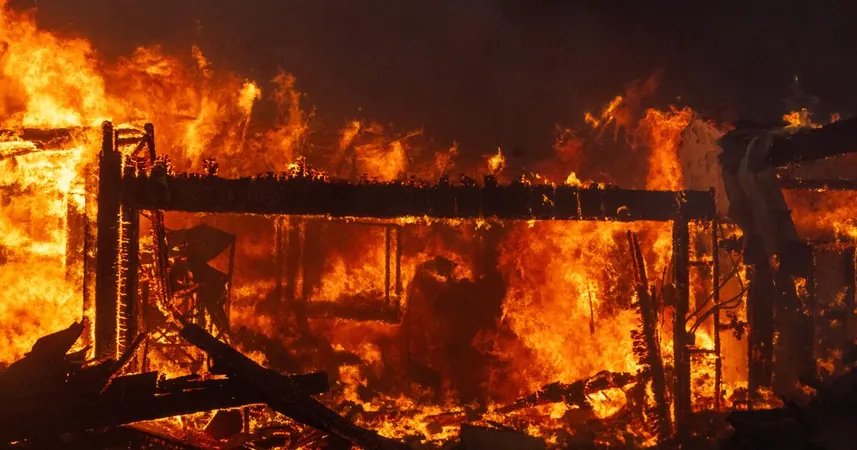
The Soaring Insurance Crisis: Will California Ever Recover from the Los Angeles Fires?
2025-01-09
Author: Wai
Overview
As wildfires erupted in Pacific Palisades and other parts of Southern California, the devastation mirrored the aftermath of a wartime bombing raid, threatening to plunge California deeper into a home insurance crisis that many thought couldn’t get worse. This catastrophe has left hundreds of thousands of residents grappling with the stark reality of securing affordable homeowners insurance, a growing challenge exacerbated by a relentless pattern of natural disasters.
Impact of the Fires
Over the span of just a few days, fires throughout Los Angeles and the San Gabriel Valley have incinerated over 2,000 structures, with initial financial estimates of damages reaching tens of billions of dollars. The Palisades fire alone, decimating more than 1,000 homes, stands as the most catastrophic fire recorded in city history. Experts are warning that these events could result in one of the costliest natural disasters in United States history.
Voices from the Community
Amy Bach, executive director of the consumer advocacy group United Policyholders, lamented, “It’s just an unmitigated disaster. Wildfires in January? This highlights the significant increase in risk due to climate change.” As if anticipating such devastating events, major insurers, including State Farm—the largest home insurer in California—previously announced they would not renew over 72,000 property insurance policies, leaving many homeowners without coverage when disaster struck.
Actor James Woods, who lost his home in the recent Palisades fire, reported that his neighborhood experienced an insurance cancellation by a major company just months prior to the disaster, leaving many homeowners vulnerable at a critical moment.
Insurance Landscape Post-Fires
The repercussions of these fires are staggering. State Farm acknowledged non-renewing over 1,600 policies in Pacific Palisades alone, which began to phase out as early as July of the previous year. With many residents now looking towards the California FAIR Plan—an insurer of last resort—homeowners are begrudgingly accepting policies that provide limited coverage. While the FAIR Plan has rapidly expanded since September 2020, from approximately 200,000 to over 450,000 policies, the depth of coverage offered is far from what private insurers traditionally provide.
Projected Financial Losses
J.P. Morgan analysts project that total losses in L.A. County might approach $50 billion, with insurers potentially facing claims upwards of $20 billion. Such overwhelming losses could prompt even more insurers to retreat from the California market, as seen with Tokio Marine America and Trans Pacific Insurance, who previously ceased offering new homeowner policies.
Rising Premiums and Tightening Market
Furthermore, skyrocketing claims could result in premium hikes for insured homeowners. Some insurers have already received significant rate increases; for instance, Allstate raised rates by 34% last year. Moody's Ratings senior analyst Denise Rappmund warned that this destructive cycle of increasing costs and diminished availability could wreak havoc on the state’s insurance market, ultimately leading to higher premiums for individuals already coping with financial strain.
Regulatory Challenges
The ongoing saga complicates the state's attempts to stabilize its insurance landscape. California’s regulations, designed to reform the insurance industry, require insurers to write policies in high-risk areas at a level equivalent to 85% of their market share. Critics argue, however, that these regulations lack the necessary enforcement mechanisms to compel insurers to adhere to coverage provisions, leading to skepticism about their effectiveness.
Future Fire Seasons
Looking forward, it is uncertain how much more damage these fires will inflict on an already beleaguered market. Insurance experts caution that a clearer understanding of losses will take time as adjusters work through claims assessments. “I think it’s going to be 45 days before we know what the true damage is,” commented Max Gilman, president at HUB International.
Moreover, challenges may ebb and flow depending on future fire seasons. Though this year saw some lighter fire activity, earlier in November, the Mountain fire in Ventura County reminded Californians of the persistent risks, scorching 20,640 acres and claiming over 130 homes.
A Path Forward?
As officials, insurers, and homeowners navigate these treacherous waters, the importance of evolving regulatory measures becomes ever-clearer. California’s path towards insurance resilience is fraught with challenges, yet some hope remains. On a positive note, just prior to the recent catastrophes, insurers like Mercury Insurance and Farmers have resumed operations in previously devastated areas, signaling a potential rebound for the industry.
Yet, with the specter of more wildfires looming and the insurance market in turmoil, one has to wonder: will California ever stabilize its home's insurance landscape, or are they destined for continual disaster? Only time will tell.





 Brasil (PT)
Brasil (PT)
 Canada (EN)
Canada (EN)
 Chile (ES)
Chile (ES)
 Česko (CS)
Česko (CS)
 대한민국 (KO)
대한민국 (KO)
 España (ES)
España (ES)
 France (FR)
France (FR)
 Hong Kong (EN)
Hong Kong (EN)
 Italia (IT)
Italia (IT)
 日本 (JA)
日本 (JA)
 Magyarország (HU)
Magyarország (HU)
 Norge (NO)
Norge (NO)
 Polska (PL)
Polska (PL)
 Schweiz (DE)
Schweiz (DE)
 Singapore (EN)
Singapore (EN)
 Sverige (SV)
Sverige (SV)
 Suomi (FI)
Suomi (FI)
 Türkiye (TR)
Türkiye (TR)
 الإمارات العربية المتحدة (AR)
الإمارات العربية المتحدة (AR)